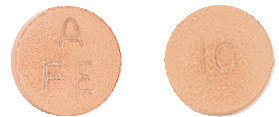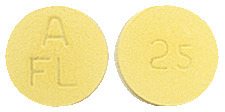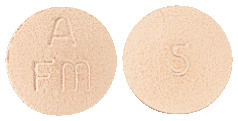SUMMARY CMI
FELODUR® ER
Consumer Medicine Information (CMI) summary
The full CMI on the next page has more details. If you are worried about using this medicine, speak to your doctor or pharmacist.
1. Why am I using FELODUR ER?
FELODUR ER contains the active ingredient Felodipine. FELODUR ER is used to treat high blood pressure, also called hypertension.
For more information, see Section 1. Why am I using FELODUR ER? in the full CMI.
2. What should I know before I take FELODUR ER?
Do not use if you have ever had an allergic reaction to FELODUR ER or any of the ingredients listed at the end of the CMI.
Talk to your doctor if you have any other medical conditions, take any other medicines, or are pregnant or plan to become pregnant or are breastfeeding.
For more information, see Section 2. What should I know before I take FELODUR ER? in the full CMI.
3. What if I am taking other medicines?
Some medicines may interfere with FELODUR ER and affect how it works.
A list of these medicines is in Section 3. What if I am taking other medicines? in the full CMI.
4. How do I take FELODUR ER?
- The usual starting dose of FELODUR ER is one 2.5 mg or 5 mg tablet taken once daily.
- If you have to take more than one tablet, you must take them together.
- Swallow tablets whole and wash them down with a glass of water. They must not be divided, crushed or chewed.
- It does not matter if you take FELODUR ER with food or not, but you must not take it with grapefruit juice.
More instructions can be found in Section 4. How do I take FELODUR ER? in the full CMI.
5. What should I know while using FELODUR ER?
| Things you should do |
|
| Things you should not do |
|
| Driving or using machines |
|
| Drinking alcohol |
|
| Looking after your medicine |
|
For more information, see Section 5. What should I know while using FELODUR ER? in the full CMI.
6. Are there any side effects?
Common side effects include: headache, swelling of the ankles, dizziness, flushing, palpitations (feeling of heart pounding), fatigue (tiredness). Uncommon side effects that may require medical attention include: swelling of the face, tongue or back of throat, harsh sounds or difficulty when breathing, skin rash, fainting, chest pain, rapid heart beat. For more information, including what to do if you have any side effects, see Section 6. Are there any side effects? in the full CMI.
FULL CMI
FELODUR® ER
Active ingredient: felodipine
Consumer Medicine Information (CMI)
This leaflet provides important information about using FELODUR ER. You should also speak to your doctor or pharmacist if you would like further information or if you have any concerns or questions about using FELODUR ER.
Where to find information in this leaflet:
1. Why am I using FELODUR ER?
2. What should I know before I take FELODUR ER?
3. What if I am taking other medicines?
4. How do I take FELODUR ER?
5. What should I know while using FELODUR ER?
6. Are there any side effects?
7. Product details
1. Why am I using FELODUR ER?
FELODUR ER contains the active ingredient felodipine. FELODUR ER is used to treat high blood pressure, also called hypertension. FELODUR ER lowers blood pressure by dilating (expanding) small blood vessels, letting the blood be pumped around the body more easily. The ER in FELODUR ER stands for Extended Release. This means that the tablets are designed to work over a 24 hour period.
FELODUR ER belongs to the family of medicines known as calcium channel blockers. These medicines do not change the way the body takes in calcium from food.
FELODUR ER helps control your high blood pressure, but does not cure it.
Treatment of high blood pressure is necessary in most people for the rest of their lives. Ask your doctor to explain the reasons for this.
2. What should I know before I take FELODUR ER?
Warnings
Do not use FELODUR ER if:
- you are allergic to felodipine, or any of the ingredients listed at the end of this leaflet. Some of the symptoms of an allergic reaction may include, tightness of the chest, wheezing, coughing or difficulty breathing, swelling of the face, lips, tongue or other parts of the body; rash, itching, hives, hayfever or feeling faint.
- Always check the ingredients to make sure you can use this medicine.
Do not take FELODUR ER if you have any of the following conditions:
- uncompensated heart failure
- acute myocardial infarction
- cardiac valvular obstruction
- dynamic cardiac outflow obstruction
- unstable angina pectoris
Check with your doctor if you:
- have any other medical conditions
- take any medicines for any other condition, including other medicines to lower blood pressure
- have any heart problem, including angina
- liver problems
- have any allergies to any other medicine used to treat high blood pressure or any other medicines, foods, preservatives, or dyes.
It may not be safe for you to take FELODUR ER if you have any of these conditions.
Tell your doctor if you are lactose intolerant.
FELODUR ER tablets contain lactose.
During treatment, you may be at risk of developing certain side effects. It is important you understand these risks and how to monitor for them. See additional information under Section 6. Are there any side effects?
Pregnancy and breastfeeding
Check with your doctor if you are pregnant or intend to become pregnant.
Talk to your doctor if you are breastfeeding or intend to breastfeed.
Do not use FELODUR ER if you are pregnant or likely to become pregnant. Ask your doctor about the risks and benefits involved.
Tell your doctor as soon as possible if you become pregnant while using FELODUR ER.
FELODUR ER should not be used during pregnancy. It may affect your baby if you take it during pregnancy.
Your baby can take in FELODUR ER from breast milk if you are breastfeeding, but it is unlikely to affect the infant when the mother is taking doses within the normal range for her treatment. Your doctor can discuss the risks and benefits involved.
Use in children
Do not give FELODUR ER to children.
There is no information on its use in children.
3. What if I am taking other medicines?
Tell your doctor or pharmacist if you are taking any other medicines, including any medicines, vitamins or supplements that you buy without a prescription from your pharmacy, supermarket or health food shop.
Some medicines may interfere with FELODUR ER and affect how it works, these include:
- cimetidine - a medicine used to treat stomach ulcers or heartburn
- medicines used to treat infections such as erythromycin and rifampicin
- treatment with FELODUR ER may affect the level of tacrolimus (a medicine given to prevent the body from rejecting a transplanted organ, e.g. kidney or liver) in your blood.
- medicines used to treat fungal infections such as itraconazole and ketoconazole
- medicines used to treat epilepsy such as phenytoin and carbamazepine
- medicines used to help you sleep such as barbiturates
- St John's Wort - a herbal remedy used to treat mood disorders
- other medicines which lower blood pressure. Your doctor may need to change the dose of them to obtain the best results for you.
These medicines may be affected by FELODUR ER or may affect the way FELODUR ER works. You may need different amounts of your medicines, or may need to take different medicines.
Medicines that may increase the effect of FELODUR ER include:
- Grapefruit juice.
Check with your doctor or pharmacist if you are not sure about what medicines, vitamins or supplements you are taking and if these affect FELODUR ER.
4. How do I take FELODUR ER?
How much to take
- Once daily, at the same time each day.
- The usual starting dose of FELODUR ER is one 2.5 mg or 5 mg tablet taken once daily.
- Your doctor will check your progress and if needed, increase your dose of FELODUR ER. Sometimes the dose will be as high as 20 mg once a day.
- If you have to take more than one tablet, you must take them together.
- Follow the instructions provided and use FELODUR ER until your doctor tells you to stop.
How to take FELODUR ER
- It does not matter if you take FELODUR ER with food or not, but you must not take it with grapefruit juice.
- Grapefruit juice may increase the effect of FELODUR ER.
- Swallow FELODUR ER tablets whole and wash them down with a glass of water. They must not be divided, crushed or chewed.
- If they are broken or crushed, they will not work over 24 hours as they are supposed to.
If you forget to take FELODUR ER
FELODUR ER should be used regularly at the same time each day. If you miss your dose at the usual time, take it as soon as you remember, as long as it is more than 12 hours before the next dose is due.
If you have trouble remembering when to take your medicine, ask your pharmacist for some hints.
If it is less than 12 hours until your next dose, skip the dose you missed and take your next dose when you are meant to.
Do not take a double dose to make up for the dose you missed.
If you take too much FELODUR ER
If you think that you have used too much FELODUR ER, you may need urgent medical attention.
You should immediately:
- phone the Poisons Information Centre
(by calling 13 11 26), or - contact your doctor, or
- go to the Emergency Department at your nearest hospital.
You should do this even if there are no signs of discomfort or poisoning.
If you take too much FELODUR ER you may experience a headache, a slow heartbeat, very low blood pressure, dizziness, tiredness or feel sick (nausea).
5. What should I know while using FELODUR ER?
Things you should do
Remind any doctor, dentist or pharmacist you visit that you are using FELODUR ER.
Keep all of your doctor's appointments so that your progress can be checked.
Call your doctor straight away if you:
- become pregnant while taking this medicine.
Things you should not do
- Do not stop taking FELODUR ER unless you have discussed it with your doctor.
- Do not take FELODUR ER with grapefruit juice. Grapefruit juice may increase the effect of FELODUR ER.
- Do not use this medicine to treat any other complaint unless your doctor tells you to.
- Do not give this medicine to anyone else, even if they have the same condition as you.
Driving or using machines
Be careful before you drive or use any machines or tools until you know how FELODUR ER affects you.
When you start taking FELODUR ER, whether you are changing from another medicine for high blood pressure or not, you may feel dizzy or faint due to the drop in your blood pressure.
Drinking alcohol
Tell your doctor if you drink alcohol.
Be careful when drinking alcohol while you are using FELODUR ER. Please talk to your doctor or pharmacist about these possibilities.
Looking after your medicine
- Store below 25°C.
- Keep your tablets in the blister pack until it is time to take them.
- If you take FELODUR ER out of the blister pack it will not keep well.
Follow the instructions in the carton on how to take care of your medicine properly.
Store it in a cool dry place away from moisture, heat or sunlight; for example, do not store it:
- in the bathroom or near a sink, or
- in the car or on window sills.
Heat and dampness can destroy some medicines.
Keep it where young children cannot reach it.
A locked cupboard at least one-and-a-half metres above the ground is a good place to store medicines.
When to discard your medicine
Do not use this medicine after the expiry date printed on the pack.
Do not use FELODUR ER if the packaging is torn or shows signs of tampering.
Getting rid of any unwanted medicine
If you no longer need to use this medicine or it is out of date, take it to any pharmacy for safe disposal.
6. Are there any side effects?
All medicines can have side effects. If you do experience any side effects, most of them are minor and temporary. However, some side effects may need medical attention.
See the information below and, if you need to, ask your doctor or pharmacist if you have any further questions about side effects.
Less serious side effects
| Less serious side effects | What to do |
Other side effects include:
| Speak to your doctor if you have any of these less serious side effects and they worry you. |
Serious side effects
| Serious side effects | What to do |
| Call your doctor straight away, or go straight to the Emergency Department at your nearest hospital if you notice any of these serious side effects. |
Tell your doctor or pharmacist if you notice anything else that may be making you feel unwell.
Other side effects not listed here may occur in some people.
Reporting side effects
After you have received medical advice for any side effects you experience, you can report side effects to the Therapeutic Goods Administration online at www.tga.gov.au/reporting-problems. By reporting side effects, you can help provide more information on the safety of this medicine.
Always make sure you speak to your doctor or pharmacist before you decide to stop taking any of your medicines.
7. Product details
This medicine is only available with a doctor's prescription.
What FELODUR ER contains
| Active ingredient (main ingredient) | felodipine |
| Other ingredients (inactive ingredients) | Hydrogenated castor oil Propyl gallate (E 310) Hypromellose Sodium aluminium silicate Microcrystalline cellulose (E 460) Lactose Sodium stearyl fumarate Hyprolose The coating on each tablet contains: Macrogol 6000 Titanium dioxide (E 171) Iron oxide yellow (E 172) Iron oxide red (E 172) (not in 2.5 mg tablet) Carnauba wax (E 903) |
| Potential allergens | Lactose |
Do not take this medicine if you are allergic to any of these ingredients.
FELODUR ER is not addictive.
What FELODUR ER looks like
FELODUR ER tablets are available in 3 strengths:
FELODUR ER 2.5 mg tablet - round, yellow, marked "A" over "FL" on one side and "2.5" on the other (AUST R 60980).
FELODUR ER 5 mg tablet - round, pink, marked "A" over "Fm" on one side and "5" on the other (AUST R 60981).
FELODUR ER 10 mg tablet - round, reddish-brown, marked "A" over "FE" on one side and "10" on the other (AUST R 60982).
All strengths are available in blister packs of 30 tablets and 7 tablets. Not all pack sizes are available.
Who distributes FELODUR ER
Clinect Pty Ltd.
120 - 132 Atlantic Drive
Keysborough VIC 3173
Australia
Free Call Australia: 1800 899 005
This leaflet was prepared in July 2024.
Published by MIMS November 2024




 MW 384.26.
MW 384.26.